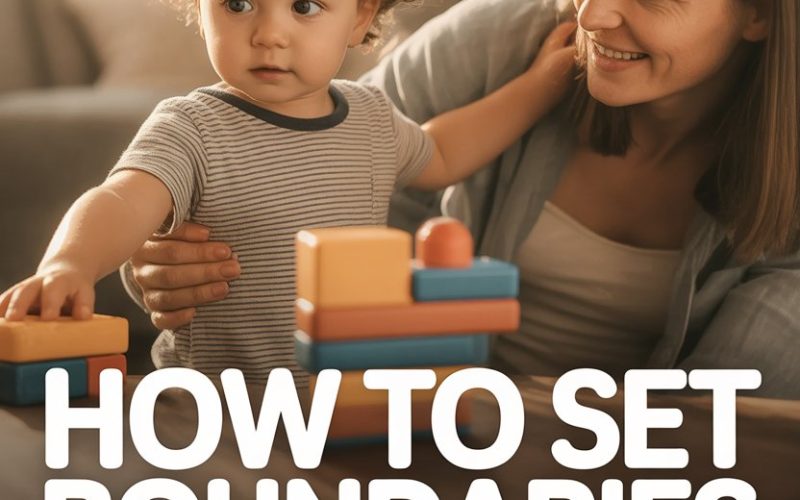Those tiny voices. Those big eyes. That iron will you never knew someone under three feet tall could possess.
You’re not alone if you find yourself exhausted by your toddler’s relentless requests (demands? commands?) for snacks, screen time, or the blue cup–no, not that blue cup, the other blue cup—with a side order of drama.
If your living room currently resembles a low-budget theatre production of “Boundary Testing: The Musical,” it’s time for a cup of tea and a chat about setting limits that actually stick.
Welcome to the art (and occasional chaos) of setting boundaries with a demanding toddler.
Why Boundaries Matter for Toddlers
Toddlers test boundaries not because they’re mini-tyrants (although, on a Monday morning, it might feel like it), but because they’re wired to learn how the world works.
According to child psychologist Dr. Laura Markham, boundaries help kids feel safe, secure, and loved—even when their wobbly lower lips suggest otherwise.
Limits don’t squash a child’s spirit. They give it room to grow in the right direction.
Like the tomato stakes for a runaway vine, boundaries don’t stop the growth—they just keep it from swallowing the fence.
Spotting the Signs: When Your Toddler Needs a Limit
When a toddler starts making the rules (or at least gives it a good try), you’ll notice classic hallmarks: demands shouted from the top of the slide, frequent meltdowns when asked to pause Peppa Pig, and an uncanny ability to sense weakness in your resolve from ten paces.
If every snack negotiation feels like a hostage situation, your child may be craving firmer boundaries. Not stricter punishments—just a bit more structure.
Consistency Is the Magic Ingredient
Ever offered a biscuit after dinner one night, but not the next, only to find yourself explaining for the hundredth time that “sometimes we have biscuits, sometimes we don’t”? Consistency is the secret sauce.
According to research from the University of Washington, clear, predictable boundaries make life easier for everyone.
If the rules shift with the weather, toddlers will keep pushing. And who can blame them? It’s hard to follow rules that keep changing.
All the fun of roulette, none of the casino glam.
Keep It Simple, Keep It Short
Lengthy explanations don’t work well for the under-fives. When you’re laying down a boundary, brevity is your best friend.
Instead of launching into a TED Talk about dental hygiene, “We brush teeth before bed” will do nicely.
If you need inspiration, borrow from nursery teachers: “We use gentle hands,” “Shoes stay on at the shops,” “We eat snacks at the table.”
These short, clear lines help toddlers know exactly where the fence stands.
Offer Choices, Not Open-Ended Freedom
Giving toddlers more control over their lives (within safe, sane limits) is a great way to reduce power struggles. The trick is to offer choices you can live with.
Would you like the red shirt or the yellow one? Grapes or apple slices? Two more minutes of play or storytime now?
Just don’t ask, “What do you want for dinner?” unless you’re prepared to serve ice cream and ketchup sandwiches.
The Art of the Calm, Firm Voice
Easier said than done, especially after a night of interrupted sleep and a day spent negotiating screen time like you’re at the UN. Still, a calm, steady tone delivers your message without adding fuel to the emotional bonfire.
Losing your cool (understandable, truly) can make toddlers anxious or even more defiant. If you need to, step away for a quick breather. The dog will listen to your rant without judgment.
Empathy: Your Secret Weapon
Setting boundaries doesn’t mean shutting down feelings. Toddlers often lose it when you say no, but their big emotions don’t mean you’ve failed.
In fact, child development experts say empathising with their frustration helps them learn to manage those wild feelings.
Try “I know you’re upset. You really wanted to play with the iPad. It’s hard to stop when you’re having fun.” Pause, then restate the limit: “It’s time for dinner now.”
Empathy doesn’t mean giving in. It just means you get it.
Stick to Routines Like Glue (Most of the Time)
Routines aren’t just for keeping your own sanity. Familiar rhythms help toddlers predict what comes next, which takes some of the drama out of daily life.
Bath, books, bed—the holy trinity of bedtime routines—can prevent many a meltdown.
That said, life happens. If the routine goes off track, be gentle with yourself. Tomorrow’s another chance.
Pick Your Battles Wisely
Yes, it’s possible to enforce every rule with the fervour of a traffic cop at rush hour, but you’ll be exhausted by noon. Decide which battles matter most (safety, health, kindness), and which ones you can let slide.
If mismatched socks or dinosaur pajamas at the supermarket aren’t hurting anyone, maybe it’s okay to let that one go.
Stay United With Your Parenting Team
Toddlers are masters at finding loopholes and playing one adult off another. If you share parenting with a partner, grandparent, or other grown-up, consistency between you is key.
A quick chat about “house rules” can save everyone from the dreaded “But Daddy lets me!” standoff.
And if you’re parenting solo, don’t forget to back yourself up—sometimes you’re the only grown-up in the room, but you’re still the best team they’ve got.
When the Meltdown Arrives (And It Will)
You’ve set the boundary. You’ve kept your cool. And yet—tears, wailing, full-body flops to the floor worthy of an Oscar.
This is normal. According to Dr. Tovah Klein, author of “How Toddlers Thrive”, young children’s emotional brains are still under construction.
Sometimes, the only thing to do is ride out the storm with as much dignity as you can muster.
Offer comfort if your child wants it, stay nearby if they need space, and remember: this too shall pass (preferably before your Zoom meeting starts).
Repair and Reconnect After Tough Moments
Nobody gets it right every time. If you lose your patience or your toddler’s feelings get bruised, repair is crucial. A simple “I’m sorry I shouted.
Parenting is hard sometimes. I love you,” works wonders.
It’s not about perfection—it’s about showing your child that everyone makes mistakes and relationships can be mended.
Tools and Tricks to Make Boundaries Easier
- Visual timers (like the classic Time Timer) can make transitions less mysterious.
- Routine charts with pictures let toddlers see what’s coming next—no reading required.
- Some parents swear by “when/then” statements: “When your toys are put away, then we can read a story.”
Find what works for your family. There’s no single right way.
Self-Care Isn’t Selfish
Caring for a demanding toddler is a full-body sport. If you’re running on empty, it’s harder to stay patient or remember why you set limits in the first place.
A few deep breaths, a chat with a mate, or five minutes hiding in the loo can do wonders for your sanity. (You’re not alone. The bathroom is officially the Parent Office.)
Boundaries Are a Gift—Even If They Don’t Feel Like It Yet
While toddlers may not send a thank-you note for your consistent, loving boundaries (unless it’s scrawled in crayon on your kitchen wall), you’re giving them something precious: safety, predictability, and the foundation for self-control.
And for you? The chance to raise a child who feels loved—and who doesn’t turn every snack request into a hostage negotiation.
Breathe deeply. Hug your little one tight.
Boundaries aren’t easy, but you’re doing a brilliant job—even if it feels like you’re starring in a never-ending episode of “Whose Rules Are They Anyway?”
Cup of tea, anyone?





